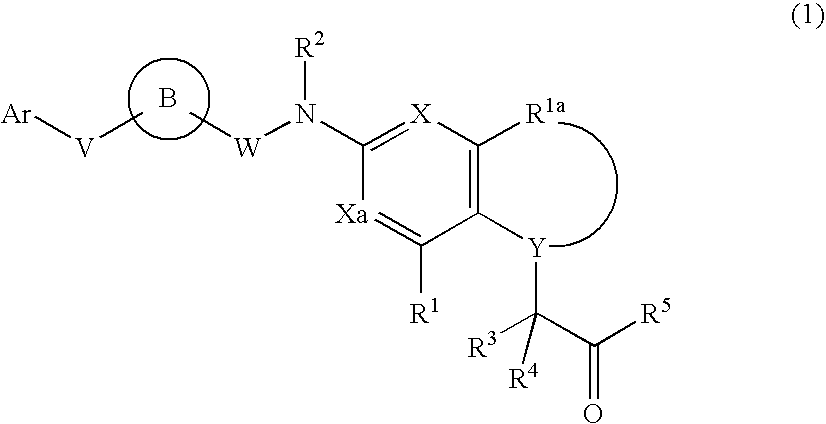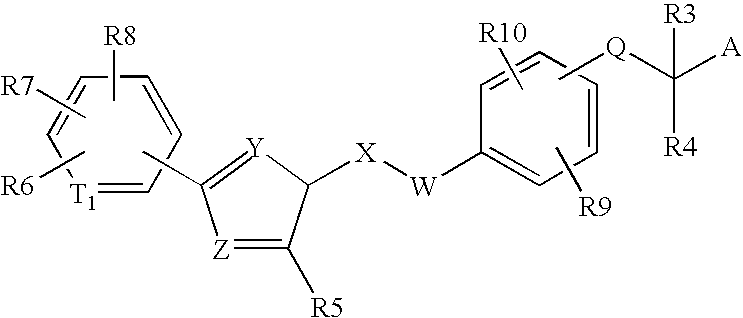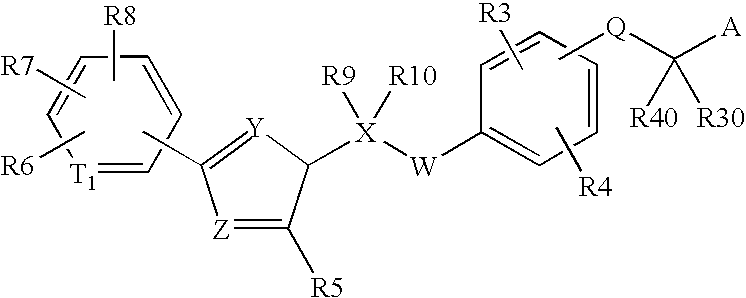Aminophenylpropanoic Acid Derivative
a technology of propanoic acid and amino acid, applied in the field of new compounds, to achieve the effect of superior gpr40 receptor function modulating action
- Summary
- Abstract
- Description
- Claims
- Application Information
AI Technical Summary
Benefits of technology
Problems solved by technology
Method used
Image
Examples
reference example 1
methyl 3-(4-aminophenyl)propanoate
[0390]
[0391]Under ice-cooling, thionyl chloride (15 mL, 206 mmol) was added dropwise to methanol (60 mL), and the mixture was stirred for 10 min. 3-(4-Aminophenyl)propanoic acid (10.1 g, 61.1 mmol) was added to the reaction mixture, and the mixture was stirred at room temperature for 18 hr. The solvent and excess thionyl chloride were evaporated under reduced pressure, and water and saturated aqueous sodium hydrogencarbonate were added. The mixture was extracted with ethyl acetate. The extract was washed with saturated brine, dried over anhydrous sodium sulfate, and concentrated under reduced pressure. The obtained solid was washed with hexane to give the title compound (10.9 g, yield 99%) as pale-brown prism crystals.
[0392]MS m / z 180 (MH+).
reference example 2
2′,6′-dimethylbiphenyl-3-carbaldehyde
[0393]
[0394]3-Bromobenzaldehyde (18.5 g, 100 mmol) and 2,6-dimethylphenylboronic acid (21.0 g, 140 mmol) were dissolved in a mixture of 1 M aqueous sodium carbonate solution (200 mL), ethanol (100 mL) and toluene (200 mL). The air was substituted with argon gas, and tetrakis(triphenylphosphine)palladium(0) (5.78 g, 5.00 mmol) was added. The reaction mixture was stirred under an argon atmosphere at 80° C. for 20 hr. After cooling the reaction mixture, water was added and the mixture was diluted with ethyl acetate. The insoluble material was filtered off through celite. The organic layer in the filtrate was washed with saturated brine, dried over anhydrous magnesium sulfate, and concentrated under reduced pressure. The residue was purified by silica gel column chromatography (hexane-10% ethyl acetate / hexane) to give the title compound (20.4 g, yield 97%) as a colorless oil.
[0395]MS m / z 211 (MH+).
reference example 3
methyl 3-(4-{[(2-nitrophenyl)sulfonyl]amino}phenyl)propanoate
[0396]
[0397]To a solution of methyl 3-(4-aminophenyl)propanoate (2.69 g, 15.0 mmol) in pyridine (20 mL) was added 2-nitrobenzenesulfonyl chloride (3.99 g, 18.0 mmol) by small portions, and the mixture was stirred at room temperature for 45 hr. The solvent was evaporated under reduced pressure, and water and ethyl acetate were added to the obtained residue. The mixture was stirred with heating at 80° C. for 15 min and filtrated through celite. The organic layer was washed with saturated brine, dried over anhydrous magnesium sulfate, and concentrated under reduced pressure. The residue was purified by silica gel column chromatography (30%-60% ethyl acetate / hexane) to give the title compound (3.39 g, yield 62%) as yellow prism crystals.
[0398]MS m / z 365 (MH+).
PUM
| Property | Measurement | Unit |
|---|---|---|
| Molar density | aaaaa | aaaaa |
| Molar density | aaaaa | aaaaa |
| Molar density | aaaaa | aaaaa |
Abstract
Description
Claims
Application Information
 Login to View More
Login to View More - R&D
- Intellectual Property
- Life Sciences
- Materials
- Tech Scout
- Unparalleled Data Quality
- Higher Quality Content
- 60% Fewer Hallucinations
Browse by: Latest US Patents, China's latest patents, Technical Efficacy Thesaurus, Application Domain, Technology Topic, Popular Technical Reports.
© 2025 PatSnap. All rights reserved.Legal|Privacy policy|Modern Slavery Act Transparency Statement|Sitemap|About US| Contact US: help@patsnap.com



